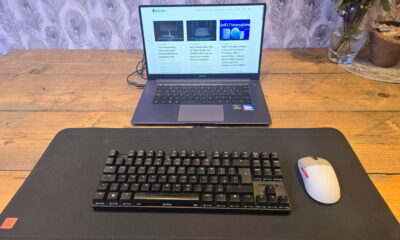Productivity
5 Best Standing Desk Converters in 2022

Here are some key features to consider when choosing a standing desk converter for your home office:
- Adjustability: Look for a converter that allows for easy transition from sitting to standing positions.
- Desktop Space: Ensure that the converter has enough space to hold your monitors, laptop, and other office supplies.
- Durability: Choose a standing desk converter made of high-quality materials that can support the weight of your equipment.
- Ease of Use: Consider how easy it is to operate the converter and make adjustments.
- Additional Features: Look for features like cable management systems, keyboard trays, and ergonomic design.
By considering these factors, you can find the best standing desk converter to improve your posture and create a more efficient workspace in your home office.
When selecting the best standing desk converter model for your home office needs, it’s important to consider various factors. The layout of your home office, the amount of time spent working there, and the specific requirements of your workspace all play a role in making the right choice. Here are some key characteristics to look for in a standing desk converter:
1. A Price That Fits Your Budget: Consider your budget and look for options that offer high-quality materials without breaking the bank. Brands like VIVO are known for producing affordable yet durable standing desk converters.
2. A Stable and Durable Surface: Ensure that the standing desk converter can support the weight of your office accessories without risking damage. Look for sturdy materials that can handle the load of monitors, laptops, and other items.
3. A Spacious Desk Top Surface: Choose a converter with enough surface space for your home office accessories, whether you need space for dual monitors, a laptop, or other items. Consider the size of the keyboard tray and make sure it fits your needs.
4. Ease of Operation: Look for a model with an easy-to-use mechanism for raising and lowering the desk. Consider your physical capabilities and choose a model that suits your needs, whether it’s operated by buttons, switches, or handles.
5. A Model That Fits Your Workspace: Find a standing desk converter that fits your unique layout, whether you have a small home office or need a two-tier or three-tier model to maximize vertical space.
6. Minimal Assembly: Consider whether you prefer a pre-assembled model or are willing to do some assembly. Check product descriptions and reviews to see how much assembly is required.
7. Consider the Ergonomics: Look for a standing desk converter with ergonomic features that promote better health and comfort while you work. Features like VESA mounts, tilting monitors, and adjustable surfaces can benefit your overall well-being.
Understanding how standing desk converters work and the different types available can help you make an informed decision when choosing the best model for your home office needs. Whether it’s an electric converter with programmable height settings or a simple manual model, finding the right standing desk converter can enhance your workspace and improve your productivity. Electric models are a great option for individuals who have difficulty lifting heavy objects or prefer to adjust their workspace with minimal effort.
– **Z-Lift standing desk converters:** The Z-Lift model is a popular choice among standing desk converters. With its z-shaped design, it is cost-effective and easy to adjust. Simply squeeze the paddles on either side of the surface to lift the desk.
– **X-Lift standing desk converters:** The X-Lift model, named for its x-shaped design, lifts straight up and down, saving space and making it easy to transition from sitting to standing.
– **Post and base standing desk converters:** These converters are free-standing and take up less desk space. They often come with monitor adjustability and enough space for a keyboard and monitor.
– **Hover standing desk converters:** Hover converters use monitor arms to hover over your desk, providing an ergonomic and space-saving option. They are ideal for collaboration and screen sharing.
– **Corner standing desk converters:** Designed for L-shaped desks, corner converters combine the features of Z-Lift, X-Lift, and electric models.
**The Difference Between Standing Desks and Standing Desk Converters:**
When choosing between standing desks and converters, consider durability and price. Standing desks are more stable but cost more, while converters allow you to keep your existing desk and are easier to install.
Both options offer benefits and drawbacks, so consider your budget, workspace layout, and design goals when making a choice. Whether you opt for a standing desk converter or a standing desk, you’ll be on your way to a healthier work environment.
-

 Destination8 months ago
Destination8 months agoSingapore Airlines CEO set to join board of Air India, BA News, BA
-

 Breaking News9 months ago
Breaking News9 months agoCroatia to reintroduce compulsory military draft as regional tensions soar
-

 Tech News11 months ago
Tech News11 months agoBangladeshi police agents accused of selling citizens’ personal information on Telegram
-

 Breaking News9 months ago
Breaking News9 months agoBangladesh crisis: Refaat Ahmed sworn in as Bangladesh’s new chief justice
-

 Productivity11 months ago
Productivity11 months agoHow Your Contact Center Can Become A Customer Engagement Center
-

 Toys11 months ago
Toys11 months ago15 of the Best Trike & Tricycles Mums Recommend
-

 Guides & Tips9 months ago
Guides & Tips9 months agoHave Unlimited Korean Food at MANY Unlimited Topokki!
-

 Gadgets3 months ago
Gadgets3 months agoSupernatural Season 16 Revival News, Cast, Plot and Release Date


















